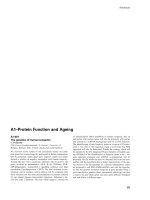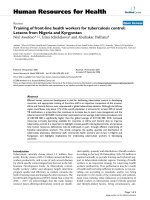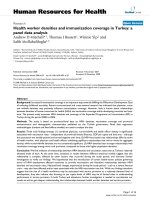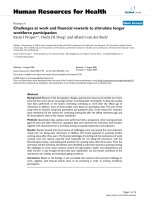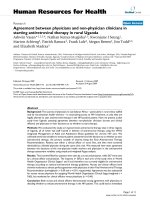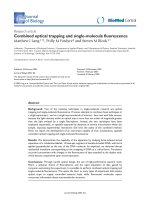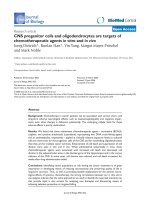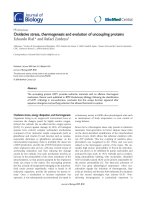Báo cáo sinh học: "Genotypic covariance matrices and their inverses for models allowing dominance and inbreeding" pptx
Bạn đang xem bản rút gọn của tài liệu. Xem và tải ngay bản đầy đủ của tài liệu tại đây (1.17 MB, 27 trang )
Original
article
Genotypic
covariance
matrices
and
their
inverses
for
models
allowing
dominance
and
inbreeding
SP
Smith
A
Mäki-Tanila*
Animal
Genetics
and
Breeding
Unit,
University
of
New
England,
Armidade,
NSW
2351,
Australia
(Received
11
June
1988;
accepted
3
July
1989)
Summary -
Dominance
models
are
parameterized
under
conditions
of
inbreeding.
The
properties
of
an
infinitesimal
dominance
model
are
reconsidered.
It
is
shown
that
mixed-
model
methodology
is
justifiable
as
normality
assumptions
can
be
met.
Tabular
methods
for
calculating
genotypic
covariances
among
inbred
relatives
are
described.
These
methods
employ
5
parameters
required
to
accommodate
additivity,
dominance
and
inbreeding.
Rules
for
calculating
inverse
genotypic
covariance
matrices
are
presented.
These
inverse
matrices
can
be
used
directly
to
set
up
the
mixed-model
equations.
The
mixed-model
methodology
allowing
for
dominance
and
inbreeding
provides
a
powerful
framework
to
better
explain
and
utilize
the
observed
variation
in
quantitative
traits.
dominance
/
inbreeding
/
infinitesimal
models
/
inverse
/
mixed
model / recursion
Résumé -
Matrices
de
covariances
génotypiques
et
leurs
inverses
dans
les
modèles
incluant
dominance
et
consanguinité.
Les
modèles
de
génétique
quantitative
incluant
la
dominance
sont
considérés
dans
des
conditions
de
consanguinité.
Après
une
discussion
des
propriétés
du
modèle
infinitésimal,
on
montre
que
la
méthodologie
des
modèles
mixtes
peut
être
appliquée
à
cette
situation,
dans
la
mesure
où
les
hypothèses
de
normalité
peuvent
être
satisfaites.
On
décrit
des
méthodes
tabulaires
pour
calculer
les
covariances
génotypiques
parmi
des
apparentés
consanguins,
dont
l’emploi
nécessite
l’introduction
de
5
composantes
de
variances.
On
présente
les
règles
du
calcul
direct
de
l’inverse
de
ces
matrices
de
covariances
génotypiques,
connaissant
la
généalogie,
et
ces
5
composantes
de
la
variance.
Ces
matrices
inverse
peuvent
être
utilisées
directement
pour
établir
les
équations
du
modèle
mixte.
La
méthodologie
du
modèle
mixte,
prenant
en
compte
les
interactions
de
dominance
et
la
consanguinité,
fournit
un
cadre
pour
une
meilleure
explication
et
une
meilleure
utilisation
de
la
variabilité
des
caractères
quantitatifs.
dominance
/
consanguinité
/
modèle
infinitésimal
/
inverse
/
modèle
mixte
/
algorithme
récursif
*
Permanent
address:
Department
of
Animal
Breeding,
Agricultural
Research
Centre
(MTTK),
31600
Jokioinen,
Finland.
**
Correspondence
and
reprints
INTRODUCTION
The
mixed
linear
model
has
enjoyed
widespread
acceptance
in
animal
breeding.
Most
applications
have
been
restricted
to
models
which
depict
additive
gene
action.
However,
there
is
also
concern
with
non-additive
effects
within
and
between
breeds
and
crosses
(eg,
Hill,
1969;
Kinghorn,
1987;
Miki-Tanila
and
Kennedy,
1986).
Henderson
(1985)
provided
a
statistical
framework
for
modelling
additive
and
non-additive
genetic
effects
when
there
is
no
inbreeding.
With
inbreeding,
the
mixed model
allows
statistical
analysis,
however,
considerable
developmental
work
remains.
Inbreeding
complicates
covariance
structures
(Harris,
1964).
Moreover,
inbreeding
depression
is
a
manifestation
of
interactions
like
dominance
and
epistasis.
Models
which
include
only
additive
effects
and
covariates
for
inbreeding
(eg,
Hudson
and
Van
Vleck,
1984)
are
rough
approximations.
The
proper
treatment
of
inbreeding
and
dominance
involves
6
genetic
parameters
(Gillois,
1964;
Harris,
1964).
These
parameters
define
the
first
and
second
moments
of
genotypic
values
in
the
absence
of
epistasis.
A
genetic
analysis
is
possible
by
repetitive
sampling
of
lines
derived
from
one
population
through
a
fixed
pedigree
(eg,
Chevalet
and
Gillois,
1977).
However,
we
should
like
to
perform
an
analysis
where
the
pedigrees
are
realized
with
selection
and/or
random
mating.
This
could
be
done
if
an
infinitesimal
model
was
feasible
and
we
could
apply
normal
theory
and
the
mixed
model.
Furthermore,
it
would
be
useful
to
build
covariance
matrices
and
inverse
structures
easily,
to
enable
use
of
Henderson’s
(1973)
mixed-model
equations.
This
paper
shows
how
to
justify
and
implement
these
activities.
It
is
an
extension
of
Smith’s
(1984)
attempt
to
generalize
models
with
dominance
and
inbreeding.
DOMINANCE
MODELS
Finite
loci
In
this
section
we
introduce
the
6
genetic
parameters
needed
to
model
additivity,
dominance
and
inbreeding
depression.
These
parameters
are
functions
of
gene
frequency
(p
i
for
the
i
th
allele)
in
much
the
same
way
that
heritability
depends
on
gene
frequency
for
purely
additive
traits.
First,
consider
the
genotypic
effect,
g
ij
for
1
locus
represented
by
where p
is
the
mean,
ai
and
aj
are
the
additive
effects
for
the
i
th
and
j
th
allele,
and
d
ij
is
the
corresponding
dominance
deviation.
Equation
(1)
represents
a
system
of
r(r
+
1)/2
equations
in
r
+
1
+
r(r
+
1)/2
unknows
(ie,
!,
ai,
aj,
d
ij
)
where
r
is
the
number
of
alleles.
To
uniquely
determine
p,
ai
and
d
ij
requires
additional
r
+
1
constraints
given
as:
These
constraints
are
derived
from
effectual
definitions
applied
to
populations
in
Hardy-Weinberg
equilibrium.
It
follows
that
in
populations
undergoing
random
mating,
the
additive
variance
is:
and
the
dominance
variance
is:
To
accommodate
inbreeding
requires
3
additional
parameters:
(i)
the
complete
inbreeding
depression:
(ii)
the
dominance
variance
among
homozygotes:
and
(iii)
the
covariance
between
additive
and
dominance
effects
among
homozy-
gotes:
It is
convenient
to
work
with
the
parameter 6
2
=
06
+ 6
which
is
a
second
moment.
The
symbol
&dquo;&dquo;’&dquo;
is
a
reminder
that
the
associated
parameter refers
to
1
locus.
When
there
are
n
loci,
then the
parameters
of
interest,
say v,
are
the
single
locus
terms v
= (8fl,
Qa, u6,
7.2
82
-2 -
&dquo;summed&dquo;
over loci.
All
parameters
terms
fol2,
fa2 a,
2, a2 - d, Ub,
2, U67 1 62
62
or
a2 bi
aa6l
&dquo;summed&dquo;
over
loci.
All parameters
in v
=
{!a,
a-d,
U6
,
U 6
62
or
a-6,
aa6)
are
formal
sums.
The
column
vector
of
inbreeding
depression
(u
6)
which
is
defined
as
a
list
of
E6
for
loci
1, 2, , n,
is
also
very
useful.
Among
the
parameters,
we
have
the
dependancies
ua
=
u u
6
and
or 6 2 = 62 _ U2 6*
The
parameters v
describe
a
hypothetical
population
of
infinite
size
undergoing
random
mating
and
inlinkage
equilibrium.
This
population
is
sometimes
referred
to
as
the
base
population,
but
we
find
this
usage
misleading.
In
the
spirit
of
Bulmer
(1971),
let
us
introduce
segregation
effects
defined
as
deviations
from
mid-parent
values.
In
fact,
both
additive
and
dominance
effects
have
mid-parents
values,
as
will
be
seen
later.
Now
we
can
define v
as
parameters
that
determine
the
stochastic
properties
of
segregation
effects
for
an
observed
sample
of
animals
from
a
known
pedigree.
Whether
or
not
these
segregation
effects
are
representative
of
some
ancestral
population
(perhaps
several
generations
old)
is,
of
course,
questionable.
Indeed,
ancestral
effects
associated
with
a
sample
of
animals
can
be
treated
as
fixed
(Graser
et
al,
1987)
and,
hence,
segregation
effects
and
estimates
of v
can
be
far
removed
from
the
ancestral
base.
This
interpretation
is
robust
under
selection,
with
the
added
assumption
that
linkage
disequilibrium
in
one
generation
influences
the
next
generation
only
through
the
mid-parent
values.
Our
assumption
need
only
be
approximately
correct
over
a
few
generations
(perhaps
far
removed
from
the
base).
It is
important
to
point
out
that
these
views
are
definitional
and
no
method
of
estimating v
(free
of
selection
bias)
has
been
proposed
as
yet.
The
disruptive
forces
of
genetic
drift
on
our
usage
of v
are
probably
of
negligible
importance;
a
small
population
is
just
another
repetition
of
a
fixed
pedigree
sampled
from
the
base
population.
Infinite
loci
It
is
feasible
to
define
an
infinitesimal
model
with
dominance
(Fisher,
1918).
When
there
is
directional
dominance,
we
might
observe
I
U6
1
going
to
infinity
or
U2
and
a!d
d
2
going
to
zero
(Robertson
and
Hill,
1983).
However,
it is
our
belief
that
this
problem
is
characteristic
of
particular
infinitesimal
models,
not
all
infinitesimal
models.
To
show
this,
we
have
constructed
a
counter
example.
Because
o, 2,a
2,
a2,
a
a6
and
U6
are
formal
sums,
it
is
necessary
(but
not
sufficient)
for
the
contributions
from
single
loci
to
be
of
the
order
n-
1
where
n
is
the
number
of
loci;
ie,
if
the
limit
of v
is
finite.
Whereas,
it
might
seem
reasonable
to
require
location
effects
like
U6
to
approach
0
at
a
rate
of
n-
1/1,
this
is
not
necessary
and
it
may
result
in
infinite
inbreeding
depression.
Now
let
us
imagine
an
infinite
number
of
loci,
each
with
4
possible
alleles,
that
could
be
sampled
with
equal
likelihood.
Assuming
that
the
dominance
deviations
for
each
locus
are as
given
in
Table
I,
these
deviations
are
consistent
with
constraints
(2).
In
this
example
it is
possible
to
use
any
additive
effects
also
consistent
with
(2),
where
a2
is
proportional
to
n-
1.
For
a
particular
locus,
the
inbreeding
depression
and
dominance
variances
are:
U6
=
-1/(2n);
a’
=
1/(4n
2)
+
3/(8n);
a2
=
1/(4n
2)
+
1/(2n).
Summed
over
n
loci
these
become:
u6
=
-1/2;
Qd
=
1/(4n)
+
3/8;
a6
=
1/(4n)
+ 1/2.
Letting
n
drift
to
infinity
gives
the
following
non-
trivial
parameters:
u6
=
-1/2;
a§
=
3/8;
or2
=
1/2.
This
provides
our
counter
example.
There
does
not not
seem
to
be
an
analogous
example
involving
only
two
alleles.
However,
the
biallelic
situation
is
uninteresting
because
it
implies
a
singularity:
-2
= a2a2
smgu arlty:
Uab -
uau8’
6*
>
The
above
demonstration
may
seem
artificial
because
it
is
spoiled
by
global
changes
in
gene
frequency
(WG
Hill,
1988,
personal
communication).
However,
we
can
construct
other
more
elaborate
counter
examples.
For
instance,
let
loci
vary
in
their
contribution
to
the
parameters.
Let
there
be
infinite
loci
indexed
1, 2, ,
n,
where
Qd
,
!6 !
0,
and
there
is
no
directional
dominance;
ie,
u6
=
0.
Among
the
partial
sum
of
n
loci,
we
can
take
approximately
n
1/2
indexed
1, 4, , k2,
where k
2
< n
<
(k
+
1)
2.
By
redefining
the
contributions
from
single
loci
to
E6
=
-n-
l/2
+
us
and
a2 a
2
<
n-
1/2
(perhaps
by
altering
gene
frequency),
we
notice
that
ub
=
-1,
and
Qd
and
!6
are
non-zero
at
the
limit
when n
goes
to
infinity.
We
can
create
yet
another
subsequence
with
indices
2, 5, ,
k2
+ 1,
where
k2
+1 <_
n
<
(k+ 1)
2
+ 1.
Taking
the
previous
alterations
and
assuming
for
the
latter
sequence
E6
=
1/2n-
1/2
+ E
6,
the
limit
value
of u
6
is
-1/2.
It
is
possible
to
select
a
finite
number
of
subsequences
and
make
similar
alterations.
Each
of
these
sequences
becomes
infinitely
long
as
n
approaches
infinity.
Hence,
infinitesimal
models,
where
0 <
J
U61
<
00
,
U2
q 0
0
and
Qa 5!
0,
are
feasible.
With
an
infinitesimal
model,
v
is
a
function
of
summary
statistics
that
involves
gene
frequency.
Individual
gene
frequencies
have
little
or
no
effect
on
v.
Moreover,
genotypic
effects
summed
over
loci
follow
a
normal
distribution.
This
implies
that
selection
and
genetic
drift
can
be
accommodated
by
the
mixed
model,
as
suggested
by
Bayesian
arguments
(eg,
Gianola
and
Fernando,
1986).
In
particular,
the
assumption
about
the
influence
of
linkage
disequilibrium,
discussed
earlier,
is
valid
under
the
infinitesimal
model.
The
real
issue
is
not
whether
[u
6
is
infinite
or
dominance
variances
are
zero,
but
whether
normality
and
linearity
are
appropriate
assumptions
given
a
finite
number
of
loci.
If
[u
6
is
estimated
from
real
data,
it
will
be
found
to
be
infinite,
although
it
may
be
very
large.
Furthermore,
if
dominance
variances
are
found
to
be
non-zero,
and
if
many
loci
are
involved,
then
it
would
seem
that
a
contrived
infinitesimal
model
(like
the
ones
above)
is
appropriate.
Normal
approximations
are
adequate
under
most
realistic
models
for
genetic
variation;
there
being
a
small
number
of
major
loci
and
a
large
number
of
minor
loci
(Robertson,
1967).
However,
with
a
very
small
number
of
loci,
these
approximations
become
less
adequate
with
each
additional
generation
of
selection.
GENOTYPIC
COVARIANCE
STRUCTURES
Harris
(1964)
developed
recursion
formulae
for
evaluating
the
identity
coefficients
needed
to
determine
covariances
among
inbred
relatives.
In
a
later
paper,
Cocker-
ham
(1971)
elaborated
on
these
methods.
Using
zygotic
networks,
Gillois
(1964)
also
devised
a
scheme
to
evaluate
identity
coefficients,
and
Nadot
and
Vaysseix
(1973)
published
an
algorithm
for
implementing
Gillois’s
procedure.
In
this
paper,
tabular
methods
for
evaluating
second
moments
are
presented.
These
techniques
allow
the
exact
evaluation
of
genotypic
covariances
without
cal-
culating
individual
identity
coefficients.
The
first
class
of
methods
are
conceptually
easy
and
are
modelled
after
the
genomic
table
described
by
Smith
and
Allaire
(1985).
The
second
class
(those
based
on
compression)
are
conceptually
more
diffi-
cult,
but
perhaps
numerically
more
feasible.
Methods
based
on
gametes
Each
animal
in
a
pedigree
receives
1
genomic
half
or
gamete
from
each
of
its
parents.
Thus,
every
animal
has
2
genomic
halves
and
the
total
number
of
such
halves
is
r
=
2s,
where
s
is
the
number
of
animals.
Let
ai
be
a
column
vector
of
additive
effects,
such
that
the
It
h
element
of
ai
equals
the
additive
contribution
of
the
l
th
locus
in
the
i
th
gamete.
If
there
are
n
loci,
then
ai
has
length
n.
Under
an
infinitesimal
model,
ai
is
infinitely
long.
Define
d
ij
as
a
vector
of
dominance
deviations,
typical
of
the
union
of
gametes
i and
j.
The
it
h
element
of
d
ij
equals
the
dominance
contribution
of
the
E!h
locus.
If
i and
j
are
genomic
halves
from
different
animals,
the
vector
d
ij
depicts
the
dominance
deviations
for
a
phantom
animal.
Like
animals,
gametes
have
a
pedigree;
genomic
halves
in
one
animal
form
a
parental
pair
for
producing
gametes.
Let
us
assume
the
gametes
are
ordered
such
that
i >
j,
if
gamete
i
is
a
descendant
of
gamete
j.
Furthermore,
let
us
assume
i
> j
implies
that
gamete j
is
a
base
population
gamete
if
i is.
Next,
imagine
the
ordered
sequence:
where
I
is
an
identity
matrix
of
order
n.
This
is
a
very
long
list
comprising
of
(r+1)(r+2)/2
arrays.
Fortunately,
we
need
only
select
a
much
smaller
subsequence,
G
=
{I,
gl,
g2
, ,
gp}
from
this
list;
ie,
the
arrays
that
are
actually
needed
for
recursive
calculations.
An
algorithm
for
extracting
G
is
presented
in
Appendix
A.
The
elements
of
G
are
used
as
row
and
column
headings
in
a
table
depicting
the
second
moments
E{G’G}
which
is
represented
by:
This
table
is
referred
to
as
the
extended
genomic
table
(cf
Smith
and
Allaire,
1985),
and
is
denoted
by
E.
Elements
of
E
are
computed
by
recursion.
Starting
with
the
first
row,
elements
are
evaluated
from
left
to
right.
When
the
first
row
is
completed,
the
first
column
is
filled
in
using
symmetry.
The
remaining
elements
in
the
second
row
are
evaluated
from
left
to
right
and
the
second
column
is
then
filled
in
using
symmetry.
This
process
is
continued
for
each
additional
row
and
column.
The
recursions
used
to
compute
E
are
listed
below,
where
B is
defined
as
the
index
set
of
all
base
gametes,
i
>
j,
k,
m,
k
>
m,
and
parent
gametes
of
i are x
and
y.
The
proofs
of these
formulae
are
due
to
properties
involving
sums
of
expectations
and
conditional
expectations.
For
example:
where
i
- x
or
y represents
the
event
that
the
t
th
locus
of
gamete
i is
identical
by
descent
to
that x
or
y,
respectively.
The
product
gig
w
is
intended
to
involve
the
gametes
i, j, k
and
m
(v
and
w are
used
to
identify
the
associated
columns
of
G).
(i)
First
n
rows:
(ii)
Subsequent
rows:
(a)
Additive
and
additive
(b)
Additive
and
dominance
(c)
Dominance
and
dominance
the
recursive
formulae
in
(c)
appears
in
Smith
(1984).
When
ie0,
the
above
recursions
are
initialized
assuming
that
gametes
are
sampled
at
random
from
a
single
population.
For
this
case,
we
have
additional
simplification
for
all
values
of i:
Now
that
the
recursive
structure
of
E
has
been
shown,
it
is
possible
to
describe
the
al
f
orithm
of
Appendix
A.
Define
f (v)
as
the
youngest
gamete
associated
with
the
vt
column
of
G,
say
g&dquo;.
The
matrix
or
list
G
is
said
to
be
closed
under
gametic
recursion
if
the
terms
used
to
expand
any
gv
by
parent
gametes
of
f (v)
are
also
of
G.
More
formally,
(g
v
I f (v) =
x)
and
(g
v
I f (v)
=
y)
are
columns
of
G
when
f(v);(),
and
has
parent
gametes
x
and
y.
The
algorithm
in
Appendix
A
is
called
a
depth-first
search
and
it
produces
sets
of
vectors
closed
under
recursion.
Any
element
needed
to
evaluate
any
recursion
can
always
be
found
in
E.
The
algorithm
of
Appendix
A
can
also
be
used
to
define
the
subsequence
G
introduced
below.
It
is
possible
to
combine
additive
and
dominance
effects
into
genotypic
effects,
say
i
ij
=
ai
+
aj
+
d
ij
,
and
use
these
as
row
and
column
headings
of
a
new
table.
The
headings
are
ordered
as
some
subsequence,
say
G,
of
The
recursions
for
E{G’G}
are
exactly
as
they
are
for
Efd
ij
}
and
Eld
’
3d
k
,,,},
except
that
initializations
(when
ie9)
are
different:
After
building
a
matrix
of
second
moments,
the
(co)variance
matrix
(for
genetic
effects
summed
over
loci)
is
obtained
by
absorbing
the
first
n
rows.
The
resulting
array
is
a
function
of u
6
only
through
u2
=
u6 U{j.
The
vwth
element
of
the
absorbed
array
E
is:
which
reflects
the
assumption
that
genotypes
are
additive
over
independently
segregating
loci.
This
assumption
can
be
relaxed,
as
linkage
disequilibrium
can
sometimes
be
accommodated
via
conditional
(ie,
Bayesian)
analyses.
In
practice,
we
never
evaluate
the
entire
array
E
or
E{G’G}.
In
particular,
the
first
n
rows
and
columns
can
be
represented
implicitly
by
one
row
and
column:
rows
of:
are
simple
multiple
of
each
other.
Our
purpose
is
to
show
structural
properties
that
allow
inversion
rules.
Nevertheless,
the
above
recursions
are
helpful
in
evaluating
particular
moments;
eg,
those
needed
to
compute
the
inverse.
This
can
be
accom-
plished
by
adapting
Tier’s
(1990)
recursive
pedigree
algorithm:
one
calculates
only
needed
moments
and
avoids
redundant
calculation.
We
may
add
to
our
recursions,
shortcuts
for
particular
degenerate
cases:
These
remarkable
results
do
not
depend
on
i
>
j,
k,
m
or
k >
m.
They
are
due
to
the
principle
of
conditional
independence
and
to
the
rule
that
probabilities
are
additive
for
mutually
exclusive
events.
The
first
rule
appeared
in
Maki-Tanila
and
Kennedy
(1986).
It
is
similar
to
a
rule
in
Crow
and
Kimura
(1970,
p
134)
based
on
additive
relationship,
although
rule
(i)
is
more
robust
under
inbreeding.
We
also
have
the
following
more
obvious
rules:
where 77
=
QabQa
2r
’Y
=
82U;
;
2,
a
=
o-!o-!!
and
p
=
ubQ! 2.
Because
E,
excluding
the
first
n
rows
and
columns,
is
at
most
of
the
order
r2
/2
by
r2
/2,
where
r
is
the
number
of
gametes,
one
might
incorrectly
conclude
that
proposed
calculations
are
prohibitive
(of
the
order
r4
/8)
and
of
no
practical
value.
Recursive
algorithms,
like
the
depth-first
search
in
Appendix
A,
can
be
surprisingly
fast.
The
value
of r
4
/8
should
be
regarded
as
an
upper
boundary
that
protects
the
algorithm
from
combinatorial
explosion -
the
kind
of
explosion
that
might
occur
when
enumerating
genetic
pathways
in
a
pathological
pedigree.
Compressed
tables
The
genomic
table
given
by
Smith
and
Allaire
(1985)
can
be
compressed.
We
may
add
together
elements
in
2
by
2
blocks
corresponding
to
animals,
and
multiply
this
matrix
by
1/2,
to
give
the
numerator
relationship
matrix.
Compression
of E
is
also
feasible,
and
has
already
been
demonstrated
above
for
a
case
involving
G.
In
general,
E
is
compressed
by
combining
columns
of
G
to
create
a
new
matrix
C.
To
be
useful,
C
should
be
smaller
than
G
and
contain
pertinent
effects.
It
is
possible
to
devise
recursive
methods
for
evaluating
E{C’C},
when
C
is
not
closed
under
recursion.
However,
methods
become
more
meticulous.
For
example,
since
the
vector
of
additive
merits
for
animals
is
not
closed
under
gametic
recursion,
we
need
to
add
inbreeding
coefficients
to
the
diagonals
when
calculating
the
numerator
relationship
matrix.
Whereas,
when
compression
is
defined
as
the
addition
of
all
G
columns,
it
is
possible
to
do
this
stochastically,
as
Harris
(1964)
has
done.
For
example,
Harris,
by
preferring
a
zygotic
analysis
over
a
gametic
analysis,
devised
a
scheme
where
entities
were
created
by
a
random
sampling
of
genes
from
existing
genotypes.
Compression
is
an
important
area
and
it
needs
to
be
developed
further.
Some
concepts
will
be
illustrated
later
by
an
example.
INVERSE STRUCTURES
General
rule
Conditions
under
which
E-’
exists
are
clarified
in
the
next
section.
For
now,
let
us
assume
that
the
inverse
exists.
Matrix
E
contains
second
moments
and
not
(co)variances
as
required
by
the
mixed
model
equations.
However,
deleting
the
first n
rows
and
columns
of
E-
1
gives
precisely
an
inverse
matrix
of
(co)variances.
The
extended
genomic
table
is
characterized
by
blocks
along
the
diagonal.
By
inspecting
labels
attached
to
vectors
in
G,
it
is
seen
that
they
come
in
groups.
For
example,
the
group
associated
with
gamete
i is
a
subsequence
of
ai,
d
li
,
d2it
d
ii
.
Likewise,
when
considering
E
=
E{G’G}
we
find
blocks
along
the
diagonal
associated
with
gametes.
Recursions
above
the
diagonal
blocks
are
functions
of
column
indices
and
not
of
row
indices.
Now
consider
a
submatrix
Ak
where
for
some
L and
Ak
contains
the
first
k
+
1 blocks.
The
matrix
L
is
a
simple
matrix
defined
by
column
indices.
If
k =
1
note
that:
for
some
Lo,
where
Ao
corresponds
to
the
base
assignments,
and
Bo
is
the
second
block.
Let
us
assume
that
Ao
is
given
(perhaps
without
the
first
n
rows
and
columns)
and
note
that:
- -
With
(B
o
—
LoA
oLo
)-
1
evaluated,
we
find
that
All
is
a
simple
function
of
AÕ
1.
Given
Ao
1,
it
is
possible
to
compute
A2
1,
where
and
B1
is
the
third
block.
In
general,
given
A-’
we
can
evaluate
A-1
1,
where
and
Bk
is
block
k
+
2.
The
general
inversion
formula
is:
To
evaluate
E-
1,
apply
this
rule
recursively
starting
with k
=
0.
It
is
hoped
that
Bk
-
L[A
kLk
will
be
sufficiently
small
or
sufficiently
sparse
so
that
its
inversion
is
feasible
(eg,
Tier
and
Smith,
1989).
For
evaluating
E-
1,
the
worst
scenario
is
that
the
order
of
Bk
-
LkA!L,!
is
r
+
1.
However,
this
occurrence
is
unlikely.
Note
that
Henderson’s
(1975)
rule
for
calculating
the
inverse
numerator
relationship
matrix
is
a
special
case
of
(3),
where
Bk
-
L’A
kLk
is
always
a
scalar.
There
are
some
notable
simplifications
when
E-
1
is
to
be
evaluated.
First,
evaluation
of
Ao
is
best
done
by
absorbing
the
first n
rows
and
then
deleting
the
first n
rows
and
columns.
The
resulting
matrix
is
some
permutation
of
a
block
diagonal
matrix
involving
2
by
2
matrices:
and
1
by
1
matrices
a§ and
ad.
This
is
a
trivial
matrix to
invert.
Second,
Bk
-
LkAkLk
has
a
peculiar
structure
that
can
be
identified
by
examining
the
recursive
definition
in
Section
IIIA.
If
block
Bk
corresponds
to
gamete
i
which
has
parent
gametes
x
and
y,
then
Lk
is
a
matrix
that
&dquo;picks&dquo;
appropriate
terms
from
Ak
that
involve
x
and
y.
Moreover,
Bk
is
also
defined
by
terms
that
involve
x
and
y.
Assume
that
the
column
headings
for
Bk
are:
It
might
be
that
i
=
jm.
Now
define
the
column
headings
where
Hx
=
(Fi
I
i =
x) =
{a!,
dxj
l’
d
Xj2’
d!,,.}
}
and
Hy =
(Fi
I
-
y) _
{ay,
dyÙ’
dYj2
7
dyj&dquo;,
I
In
the
definition
of
Hx
and
H!,
it
is
understood
that
d
Xj
&dquo;,
=
d!!
and
d!j&dquo;,
=
dyy,
if
i
=
j&dquo;,.
Select
elements
from
Ak
and
build
the
matrix,
where
M!!
=
E{HxH!},
Mxy
=
M!!
=
E{H
x
Hy},
and
Myy
=
EIH’Hy}.
A
direct
application
of
the
recursions
gives:
Futhermore,
as
Lk
is
a
matrix
that
&dquo;picks&dquo;
terms
under
headings
H!
and
H!:
and
thus:
Equation
(5)
can
also
be
derived
if B,!-L!A,!Lk
is
recognized
as
the
(co)variance
matrix
for
the
segregation
effects
due
to
recombination
of
gametes x
and
y
in
the
formation
of
gamete
i.
The
mid-parent
values
of
Fi
are
the
column
vectors
of
1/2H!
+
1/2Hy.
As
the
segregation
effects,
S
=
F! - 1/2H! - 1/2H!,
have
a
mean
of
zero,
the
(co)variance
matrix
is:
where
S
=
1/2H! -
1/2Hy.
Evaluating
E{S’S}
gives
eqn(5).
Finally,
in
rule
(3)
Lk
(B
k
-
L!A,!Lk)-1L!,
-L
k
(B
k
-
L’A
kLk
)-
l
and
(B! - Lj!A!L!) !
are
contributions
added
under
H
by
H
headings,
H
by F
i
head-
ings,
and
Fi
by
Fi
headings,
respectively.
Existence
of
inverses
When
there
is
no
inbreeding,
E-
1
can
be
shown
to
exist.
First,
we
present
the
following
Lemma:
Lemma
1:
In
the
absence
of
inbreeding,
there
exists
a
matrix
Mk,
which
is
a
submatrix
of
Ak,
and
there
exists
a
matrix
Xk
of
full
column
rank
such
that:
where
B!,,L,!
and
Ak
are
associated
with
E.
Proof.
Because
equ(5)
is
given,
we
only
prove
that
such
M!
and
Xk
can
be
found
where XkM
kXk
=
1/4(M!! -
M!! -
M!!
+
Myy).
The
matrix
Mk,
defined
by
eqn(4),
will
be
’a
submatrix
of
Ak
if
there
are
no
indices
jm
= i,
jv
= x
and j
w
=
y
used
in
the
definition
of
Fi.
The
algorithm
presented
in
Appendix
A
will
not
create
indices
j&dquo;,,
= i,
jv
= x
and j
w
=
y
when
there
is
no
inbreeding.
For
this
case,
we
can
take
Mk
=
Mk,
and ’
=
1/2{I,
-I},
where
the
identity
matrix
I
has
order
m
+
1.
Matrix
Xk
has
full
column
rank
((a.E.D).
Theorem
1:
If
E
is
constructed
by
applying
the
recursion
rules
to
some
finite
and
non-inbred
pedigree,
then
E-
1
exists,
provided:
Proof.
The
matrix
Ao
is
non-singular
when
the
condition
of
the
theorem
holds.
Now
assume
that
A-’
exists,
then
by
the
inversion
rule
(3)
A!+1
exists
if
(B
k
-
L’A
kLk
)-’
exists.
By
the
above
Lemma,
Bk
-
LkA
kLk
=
3CkM
k
Xk-
Because
Mk
is
a
submatrix
of
Ak,
it
is
non-singular.
Therefore,
(X!M!X!)-1
exists
because
Xk
has
full
column
rank.
We
conclude
that
the
existence
of
Ak
1
implies
the
existence
of A!+1.
As
AÕ1
exists,
the
theorem
follows
by
mathematical
induction
(Q.E.D).
The
reader
might
think
that
the
concurrence
of
identical
twins
would
contradict
Theorem
1.
However,
this
is
not
the
case,
as
the
theory
assumes
that
gametes
are
distinct
and
can
be
ordered
using
indices.
Thus,
for
identical
twins,
the
recursive
formulae
presented
earlier
are
incomplete.
This
is
not
a
practical
problem,
as
identical
gametes
can
be
represented
only
once
in
G.
Henderson
(1985)
considered
a
non-inbred
population
and
studied
a
dominance
relationship
matrix
D.
He
used
D-
1
in
many
formulae
without
proof
of its
existence.
However,
as
D
is
a
submatrix
of
E,
the
theorem
implies
that
D-
1
exists.
When
there
is
inbreeding,
the
algorithm
in
Appendix
A
will
produce
labels
like
dii,
di.
and
diy,
where
i!9
and
has
parent
gametes
x
and
y.
In
general,
E
is
singular
because
of
the
dependence:
Even
with
inbreeding,
4
labels
like
those
in
eqn(6)
need
not
occur
together
as
headings
of
E.
However,
it
is
possible
to
merge
the
identity
(6)
with
the
recursion
and
remove
d
ii
for
I(0
from
the
sequence
G
to
get
G -
see
Appendix
A.
The
vector
G
is
closed
under
recursion
if
eqn(6)
is
used
to
redefine
d
ii
for
i18.
The
matrix
of
second
moments
E
=
Eli7x4U}
has
no
row
and
column
heading
d
ii
for
I(0
and
it
is
non-singular.
To
prove
this,
we
introduce
Lemma
2
for
E.
First, let
us
imagine
that
Bk
-
LkAkL!
corresponds
to
a
particular
absorbed
block
of
E.
Lemma
2:
There
exists
a
matrix
Mk,
which
is
a
submatrix
of A
k,
and
there
exists
a
matrix
X!
of
full-column
rank,
such
that
Bk
-
L’A
kLk
=
4
where
Bk,
Lk
and
Ak
are
associated
with
E.
Proof
Because
the
pedigree
is
inbred,
we
expect
indices j,
=
x
and
jw
=
y
(x,
y
parents
of
i)
in
the
definition
of
Fi
- otherwise,
follow
the
proof
of
Lemma
1.
By
construction,
there
is
no
index
jm
= i.
This
implies
that
there
will
be
vectors
dx
y,
d
xx
=
dxx, +dxx,,-dx!x&dquo;
and
dyy
= d!yx+d!yy-dyzyv
in
H,
where x
x,
xy
and
yx
, yy
are
parent
gametes
of x
and
y,
respectively.
With
no
loss
in
generality,
switch
the
vectors
ai
with
d
ix
,
and
diy
with
di!&dquo;,
in
Fi.
So
as
to
maintain
consistency
with
the
definition
H
=
{H
x
=
(Fi I
i =
x),
Hy =
(F
i
i
=
y)},
columns
of
H
may
be
altered
by
switching:
These
permutations
preserve
the
identity
where
Xk
=
1/2{I,
-I}
and
Mk
=
E{H’H}
if
we
further
stipulate
that
selected
columns
of
G
have
also
been
rearranged.
Note
that
columns
and
rows
m
+
1
and
m+2
2 in
Mk
are
redundant,
as
they
are
both
represented
by
dxy
=
dy
x.
Therefore,
we
may
delete
row
and
column
m
+
2
to
create
Mk
(delete
column
m
+
2
in
H)
and
note
that
where
and
I
has
order
m —
2.
Clearly,
ik
is
of
full-column
rank
and
is
a
candidate
for
Xk.
When
x
and
y are
base
gametes
(ie,
xx,
x!,
Yx
and yy
are
unknown),
we
are
finished
as
we
can
take
M!
=
Rk,
which
is
a
submatrix
of
Ak.
Unfortunately,
when
at
least
one
of the
zygotes
(x
x
,xy)
and
(
Yx
,yy)
are
known,
Mk
is
not
a
submatrix
of
Ak
because
of
the
composite
vectors
d!x
and/or
dy
We
assume
that
both
(x
x,
yy)
and
(y
x
, y
x)
are
known
in
the
remainder
of
the
proof
(when
only
1
zygote
is
known,
the
argument
can
be
modified
slightly).
It
might
be
that
d
xx
&dquo;
and
d!!&dquo;
exist
already
between
columns
2
and
m
in
the
redefined
H.
Likewise,
d.y.
and
d!!&dquo;
may
exist
beyond
position
m.
If
any
of
the
labels
xx!,
xxy
7
yy
x
and
yyy
do
not
exist,
we
introduce
them
as
dominance
vectors
in
H.
Further,
we
may
redefine
the
first
and
last
columns
to
represent
labels
zz
zy
and
yx
yy,
respectively.
This
gives
us
a
modified
matrix
Because
G
is
c_losed
under
recursion,
all
columns
of
H
are
in
G.
Moreover,
all
columns
of
H
are
unique;
XxX
y =1=
yxy!,
because
animals
cannot
mate
with
themselves.
We
conclude
that
the
matrix
is
a
submatrix
of
Ak.
Now
define
the
matrix
/
.
I
r.
B.
where
m
and
f
are
null
vectors,
except
for
ones
at
positions
corresponding
to
zz
z,
X
xy
l
yy
x
and
yyy;
M
and
F
are
like
identity
matrices,
except
that
rows
corresponding
to
zz
z,
xxy,
YYx
and
yyy
would
be
deleted
if
the
corresponding
columns
were
introduced
into
H.
Now
Xk
has
full-column
rank.
Since
the
Lemma
is
proved
(Q.E.D).
Theorem
2:
If
E
is
constructed
by
applying
recursion
modified
by
equ(6)
to
some
finite
pedigree,
then
E
exists,
provided
Proof.
With
the
first n
rows
absorbed,
Ao
is
non-singular
when
the
condition
of
the
theorem
holds.
Therefore,
Ao
is
non-singular
when
the
first
n
rows
are
intact.
The
remainder
of
the
proof
is
identical
to
that of
Theorem
1,
except
that
reference
is
made
to
Lemma
2,
rather
than
Lemma
1
(Q.E.D).
We
should
expect
singularities
when
inbreeding
coefficients
approach
unity,
as
occurs
with
the
numerator
relationship
matrix.
Indeed,
the
matrix
S
=
1/2H
x
-
1/2Hy
becomes
a
null
matrix
when
gametes x
and y are
identically
equal.
As
E{S’S}
equals
eqn(5),
the
absorbed
block
for
gamete
i
is
a
matrix
of
zeros
and
E
is
singular.
Our
construction
of
E
assumes
that
the
base
population
is
a
random
set
of
unrelated
gametes
which
have
been
sampled
from
some
infinite
population;
that
is
even
though
the
base
population
is
finite,
inbreeding
in
the
base does
not
exist.
Under
diploidy,
inbreeding
coefficients
cannot
be
unity
with
finite
pedigrees.
Feasibility
It
is
beyond
the
scope
of
the
present
paper
to
demonstrate
the
calculation
of
E-
1
for
a
real
population.
However,
we
have
applied
the
algorithm
in
Appendix
A
to
a
pedigree
borrowed
from
a
beef
cattle
selection
experiment
conducted
at
the
Agri-
cultural
Research
Centre,
Trangie,
NSW
(PF
Parnell
(1988),
personal
communica-
tion).
The
pedigree
involved
1 122
animals
with
records
and
625
ancestors
without
records.
The
average
number
of
generations
on
the
female
side
was
9
and
the
maxi-
mum
was
16.
On
the
male
side,
the
average
was
8
generations,
with
a
maximum
of
13.
There
were
only
55
base
gametes,
and
the
average
inbreeding
of
the
population
was
0.1
(the
maximum
was
0.26).
The
order
of
E
and
E
was
about
190 000.
Matrix
Ao
was
of
the
order
1595.
However,
excluding
Ao,
the
maximum
block
sizes
were
321
and
323,
respectively.
The
distribution
of
block
sizes
is
presented
in
Table
II.
Most
of
the
blocks
were
of
the
order
2
and
3.
Given
the
absorbed
blocks,
and
ignoring
possible
singularities,
matrices
E-
1
and
E
can
be
evaluated.
The
computations
are
not
trivial,
but
are
feasible.
There
are
other
approaches
to
modelling
dominance
that
do
not
involve
E-
1
or
E-
1.
For
example,
we
might
extract
from
E
only
those
elements
that
involve
animals
or
animals
with
records.
If the
extracted
matrix
is
put
into
a
matrix
D,
then
we
could
attempt
to
evaluate
D-
1
using
sparse
matrix
absorption
(Tier
and
Smith,
1989).
Then
U-
1
could
be
used
in
the
mixed-model
equations.
Alternatively,
D
could
be
used
directly
in
the
same
way
that
Henderson
(1985)
used
D.
Because
E
is
an
enlarged
matrix
with
unrealized
combinations
of
gametes
(the
so-called
phantom
animals),
alternatives
to
E-
1
are
attractive.
However,
breeding
schemes
that
utilize
dominance
variation
are
bound
to
require
the
prediction
of
dominance
effects
that
correspond
to
untried
gamete
pairs
(say,
among
gametes
of
parents
that
contribute
genes
to
the
next
generation).
Further
research
is
needed
to
evaluate
all
competing
methods.
ILLUSTRATION
In
this
section
we
demonstrate
our
methods,
using
the
simple
pedigree
displayed
in
Fig.
1.
This
pedigree
involves
4
animals
or
8
genomic
halves.
For
simplicity,
we
assume
or2
=
or
=
1;
U2
=
a2
=
0.
Given
that
gametes
pairs
12,
35,
64
and
78
represent
dominance
vectors
for
animals
and
are
to
be
included
in
G,
the
algorithm
of
Appendix
A
creates
14
additional
pairs -
ignoring
first
array
I
and
additive
vec-
tors.
The
matrix
G
is
given
as
row
and
column
labels
of
Table
III.
Second
moments
of
Table
III
are
derived
by
applying
the
recursion
of
formulae.
For
example,
the
element
Eld’2ld5il
was
calculated
as
1/2EId’
ld
ll
}
+
1/2EId’
ld
2ll
= 0 + 1/2
= 1/2.
To
evaluate
E-
1
requires
the
determination
of
(A
2
-
LiBiL!)-1
for
i =
0,1, 2, 3.
The
absorbed
blocks
can
be
evaluated
recursively,
but
for
now,
the
reader
may
obtain
these
by
applying
Gaussian
elimination
directly
to
Table
III.
The
inverse
blocks
are:
The
matrices
L!
for
i
=
0,1,2,3,
are
displayed
below
the
diagonal
in
Table
IV.
In
accordance
with
formulae
(3),
the
elements
of
E-
1
are
given
above
the
diagonal.
We
can
now
compress
E
by
defining
db
=
du
+
d
22
(with
labels,
this
is
notated
as
b:
11
+
22),
d,
=
d
31
+
d
32
,
dd
=
d
41
+
d
42
,
d
f =
dsi
+
d
52
,
di
=
d
74
+
d
76
.
These
definitions,
as
well
as
other
symbolic
definitions,
are
given
as
row
labels
for
the
compressed
matrix
of
Table
V.
As
an
exercise,
the
compressed
table
can
be
evaluated
by
inspecting
Table
III
and
adding
together
appropriate
elements.
For
example,
E{djd¡}
can
be
computed
by
adding
together
4
elements
of
Table
III:
real
challenge
is
to
find
simplifying
recursions
that
allow
evaluation
of
com-
pressed
tables.
In
order
to
apply
inversion
formulae
(3),
recursions
to
the
right
of
blocks
along
the
diagonal
should
be
maintained
exclusively
as
a
function
of
column
index,
as
in
the
present
example.
These
recursions
are
given
implicitly
below
the
diagonal
in
Table
VI
as
matrices
Li
for
i =
0,1, 2, 3.
For
example,
the
element
E(d )di )can
also
be
obtained
by
adding
The
blocks
(A
i
-
LiB
iL
il
-1
for
i
=
0,1, 2,
are:
Inverse
elements
of
the
compressed
matrix
are
given
above
the
diagonal
in
Table
VI.
DISCUSSION
Although
we
have
not
emphasized
the
evaluation
of
various
identity
coefficients,
gametic
recursion
of
such
coefficients
is
feasible.
Moreover,
gametic
recursions,
like
those
used
to
define
E,
are
very
easy
to
understand
and
may
provide
an
approach
useful
in
teaching,
whilst
there
may
be
more
complicated
(but
perhaps
numerically
more
efficient)
alternatives.
But
gametic
recursion
need
not
be
numerically
ineffi-
cient
and
is
certainly
not
subject
to
combinatorial
explosion.
Depth-first
searches,
like
the
algorithm
of
Appendix
A,
can
be
used
to
implement
gametic
recursion
in
an
efficient
way.
For
example,
to
evaluate
inbreeding
coefficients
via
gametic
recursion,
one
would
first
conceive
of
a
symmetric
table
with
r2
/2
elements.
However,
r2
/2
operations
are
not
required
to
evaluate
inbreeding
coeflicients
via
gametic
recur-
sion.
All
that
is
needed
is
to
identify
labels
i j
of
the
dominance
vectors
d
ij
in
G.
By
moving
down
a
list
of
such
labels,
it
is
possible
to
evaluate
the
coefficients
using
one
work
vector.
We
need
only
modify
this
scenario
for
general
identity
coefficients.
The
simplest
explanation
of
the
two
commonly
found
and
complementary
phe-
nomena
(heterosis
and
inbreeding
depression)
is
that
there
is
dominance
of
alleles
at
many
loci.
Therefore,
dominance
should
be
regarded
as
an
essential
feature
of
genetic
models
for
loci
affecting
quantitative
traits.
Characteristics
closely
con-
nected
with
fitness,
such
as
reproduction,
would
mostly
have
only
non-additive
variation
left,
as
the
additive
has
been
exhausted
(Robertson,
1955).
There
are
also
suggestions
that
dominance
of
alleles
that
maintain
normal
enzyme
activity,
is
a
universal
biochemical
property
(Kacser
and
Burns,
1981).
It
is
clear
that
additivity,
dominance
and
inbreeding
can
be
modelled
by
applying
mixed-model
methodology.
The
ramifications
of
such
a
development
are
far
reaching.
We
list
possible
applications:
Determination
of
optimum
and
dynamic
mating
structures
which
capitalize
on
additive
and
dominance
variance
while
providing
for
inbreeding.
Some
of
these
breeding
strategies
can
be
studied
by
the
use
of
moment-generating
matrices
for
regular
mating
systems.
Cockerham
( 1971)
has
given
an
example
of
such
a
transition
matrix
for
full-sib
mating.
Possible
application
areas
are:
(a)
mate
selection
(Jansen
and
Wilton,
1985;
Smith
and
Allaire,
1985);
(b)
group
selection
(Jansen,
1985;
Smith
and
Hammond,
1987)
when
the
selection
of
a
random
mating
gene
pool
is
created
by
a
finite
number
of
parents.
The
objective
of
group
selection
is
to
improve
both
additive
merit
and
the
average
specific
combining
ability
of
genes
in
the
pool;
(c)
crossbreeding
plans
to
utilize
between
breed
additive
and
heterotic
effects
(Kinghorn,
1987);
(d)
selection
of
clones
and
animals
created
by
futuristic
techniques.
(ii)
To
allow
dominance
variance
to
be
partitioned,
and
thus,
remove
some
of
the
confounding
that
would
otherwise
corrupt
statistical
analyses.
(iii)
To
improve
our
understanding
of
traits
which
are
likely
to
show
considerable
amounts
of
non-additive
genetic
variation.
This
understanding
can
be
advanced
by
simulation
studies,
eg,
concerning
selection
bias
and
finite
loci.
Other
studies
may
involve
simulation
of infinitesimal
models
with
dominance
via
sampling
from
normal
distributions.
The
theory
we
present
here
is
still
very
underdeveloped.
New
methods
are
needed
for
the
estimation
of
genetic
parameters,
as
past
approaches
have
met
with
very
limited
success
(eg,
Gallais,
1977).
It
is
our
belief
that
an
extension
of
the
derivative-free
algorithm
of
Graser
et
al.
(1987)
is
possible,
and
consequently,
genetic
parameters
could
be
estimated
by
restricted
maximum
likelihood.
Research
is
needed
in
the
area
of
computing
strategies
(eg,
compression,
inversion).
Further,
models
which
allow
different
parameters
for
different
populations
would
be
useful
in
crossbreeding
studies.
A
multivariate
extension
of
our
work
would
also
be
desirable.
The
forgotten
papers
of
Harris
(1964)
and
Gillois
(1964)
have
been
resurrected.
While
the
methods
are
arguably
complicated,
they
are,
however,
feasible.
Whereas,
classical
quantitative
genetics
is
unable
to
fully
utilize
information
on
dominance
and
inbreeding
in
predictions,
the
appropriate
mixed
model
under
a
wide
range
of
assumptions,
including
selection
and
environmental
noise,
does
that.
ACKNOWLEDGEMENTS
The
authors
thank
Keith
Hammond
for his
encouragement.
This
work
was
sup-
ported
by
the
Australian
Meat
and
Livestock
Research
and
Development
Corpora-
tion,
the
Australian
Pig
Research
Council,
and
the
Finnish
Agricultural
Research
Council.
REFERENCES
Bulmer
MG
(1971)
The
effect
of
selection
on
genetic
variability.
Am
Nat
105,
201-
211
Chevalet
CL,
Gillois
M
(1977)
Estimation
of
genotypic
variance
components
with
dominance
in
small
consanguineous
populations,
Proc
Int
Conf
on
Quantitative
Genetics.
(Pollak
E,
Kempthorne
0,
Bailey
TB
Jr,
eds).
Iowa
State
University
Press,
Ames
271-296
Cockerham
CC
(1971)
Higher
order
probability
functions
of
identity
of
alleles
by
descent.
Genetics
69,
235-246
Crow
JF,
Kimura
M
(1970)
An
Introduction
to
Population
Genetics
Theory.
Harper
and
Row,
New
York
Fisher
RA
(1918)
The
correlation
between
relatives
on
the
supposition
of Mendelian
inheritance.
Trans
R
Soc
Edinburgh
52,
399-433
Gallais
A
(1977)
An
experimental
check
of
quantitative
genetics
on
an
autote-
traploid
plant,
Medicago
sativa
L,
with
special
reference
to
the
identity
by
descent
relationship.
Proc
Int
Conf
Quantitative
Genetics,
(Pollak
E,
Kempthorne
0,
Bailey
TB
Jr,
eds)
Iowa
State
University
Press,
Ames,
pp
519-540
Gianola
D,
Fernando
RL
(1986)
Bayesian
methods
in
animal
breeding
theory.
J
Anim
Sci
63,
217-244
Gillois
M
(1964)
La
relation
d’identit6
en
g6n6tique.
These
Fac
Sci
Paris
Graser
HU,
Smith
SP,
Tier
B
(1987)
A
derivative-free
approach
for
estimating
variance
components
in
animal
models
by
restricted
maximum
likelihood.
J
Anim
Sci
64,
1362-1370
Harris
DL
(1964)
Genotypic
covariances
between
inbred
relatives.
Genetics
50, 1319-
1348
Henderson
CR
(1973)
Sire
evaluation
and
genetic
trends.
Proc.
of
the
Animal
Breeding
and
Genetic
Symp.
in
Honor
of Dr
Jay
L
Lush,
ASAS-ADSA,
Champaign,
10-41
Henderson
CR
(1975)
Rapid
method
for
computing
the
inverse
of
the
relationship
matrix.
J Dairy
Sci 58,
1727-1730
Henderson
CR
(1985)
Best
linear
unbiased
prediction
of
non-additive
merits
in
non-inbred
populations.
J
Anim
Sci
60,
111-117
Hill
WG
(1969)
The
rate
of
selection
advance
for
non-additive
loci.
Genet
Res
13,
165-173
Hudson
GFS,
Van
Vleck
LD
(1984)
Effect
of
inbreeding
on
milk
and
fat
production,
stayability,
and
calving
interval
of
registered
Ayrshire
cattle
in
the
Northeastern
United
States.
J
Dairy
Sci
67, 171-179
Jansen
GB
(1985)
Selection
and
mating
strategies
to
improve
quadratic
merit.
PhD
Thesis,
The
University
of
Guelph
Jansen
GB,
Wilton
JW
(1985)
Selecting
mating
pairs
with
linear
programming
techniques.
J Dairy
Sci 68,
1302-1305
Kacser
H,
Burns
JA
(1981)
The
molecular
basis
of
dominance.
Genetics
97, 639-666
Kinghorn
B
(1987)
On
computing
strategies
for
mate
allocation.
Z
Tierziichtg
Ziichtgsbiol 104,
12-22
Maki-Tanila
A,
Kennedy
BW
(1986)
Mixed
model
methodology
under
genetic
models
with
a
small
number
of
additive
and
non-additive
loci.
Proc
3rd
World
Congr
Genetics
Applied
Livestock
Prod
XII,
443-448
Nadot
R,
Vaysseix
G
(1973)
Apparentement
et
identite.
Algorithme
de
calcul
des
coeflicients
d’identit6.
Biometrics
29,
347-359
Robertson
A
(1955)
Selection
in
animals:
synthesis
Cold
Spring
Harbor
Symp.
Quant
Biol
20,
225-229
Robertson
A
(1967)
The
Nature
of
Quantitative
Variation.
Heritage
frorn,
Mendel
(Brink
RA,
Styles
ED,
eds)
University
of
Wisconsin
Press,
Madison,
265-280
Robertson
A,
Hill
WG
(1983)
Population
and
quantitative
genetics
of
many
linked
loci
in
finite
populations.
Proc.
R.
Soc.
London
B
219,
253-264
Smith
SP
(1984)
Dominance
relationship
matrix
and
inverse
for
an
inbred
popula-
tion.
Unpublished
mimeo,
Dept
of
Dairy
Sci,
Ohio
State
University,
Columbus
Smith
SP,
Allaire
FR
(1985)
Efficient
selection
rules
to
increase
non-linear
merit:
application
in
mate
selection.
Genet
Sel
Evol
17,
387-406
Smith
SP,
Hammond
K
(1987)
Portfolio
theory,
utility
theory
and
mate
selection.
Genet
Sel
Evol 19,
321-336
Tier
B
(1990)
Computing
inbreeding
coefficients
quickly.
Genet
Sel
Evol
(in
press)
Tier
B,
Smith
SP
(1990)
Use
of
sparse
matrix
absorption
in
animal
breeding.
Genet
Sel
Evol2l,
457-466
APPENDIX
A
Depth-first
search
for
extracting
gamete
pairs
The
following
account
deals
with
the
extraction
of
labels
ij
of
the
dominance
vectors
d
ij
of
G.
To
identify
the
additive
vectors,
simply
require
both
ai
and
aj
to
be
included
in
the
list if
d
ij
is.
All
gamete
indices
are
assumed
to
have
been
transformed,
such
that
base
gametes
come
first
and
ancestors
preceed
their
descendants.
1.
Definitions
(a)
FLAG(I,J)
is
an
indicator
variable.
Upon
completion
of
the
search,
FLAG(I,J)
is
true
when
pair
IJ
has
been
selected,
and
false
otherwise.
That
is,
FLAG(I,J)
provides
the
gametic
pair
associated
with
the
dominance
vector
d
ij
,
using
the
convention
that
I
=
i
and
J
= j.
FLAG
can
be
a
very
large
array
because
each
of
the
IJ
entries
need
only
occupy
one
bit
of
computer
memory.
(b)
PEDIGR(1,I),
PEDIGR(2,I)
are
parent
gametes
of
gamete
I.
(c)
WORK(1,I),
WORK(2,I)
is
a
work
space
indexed
by
I.
